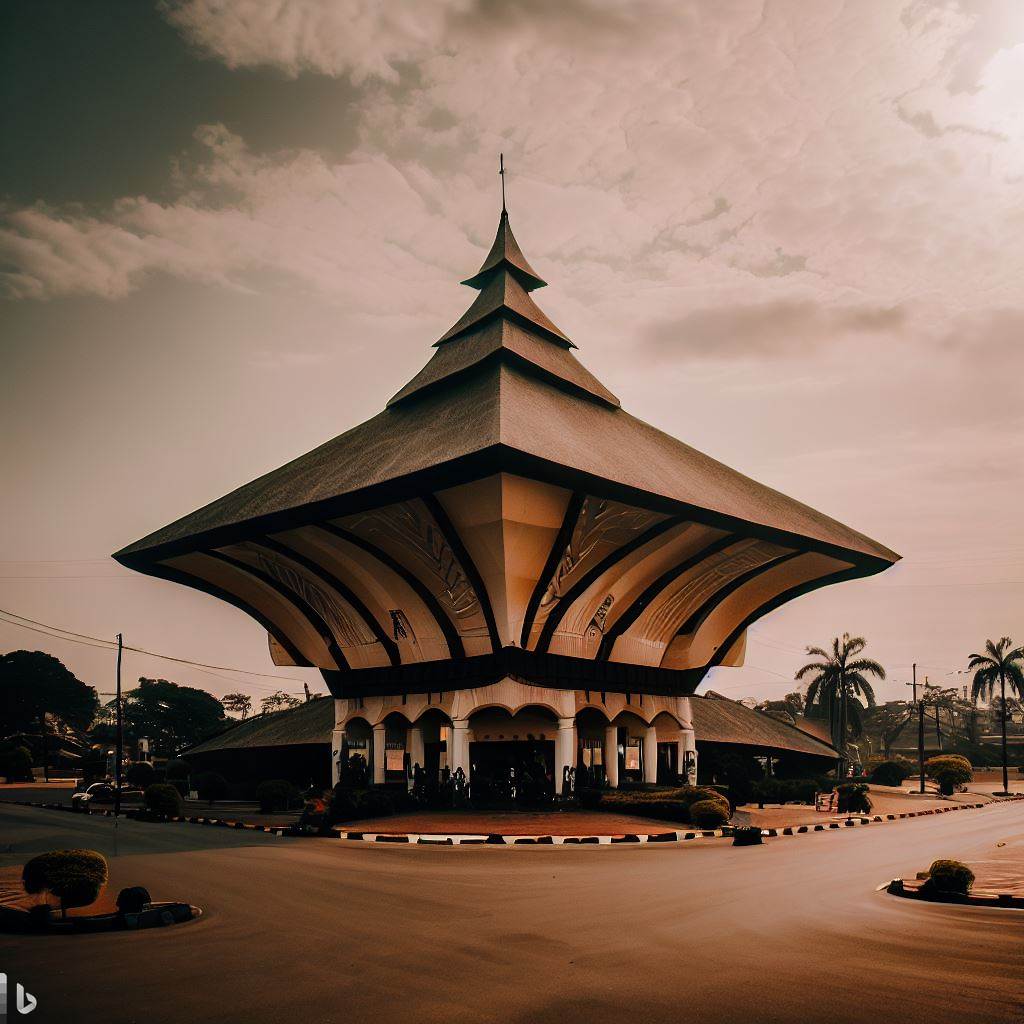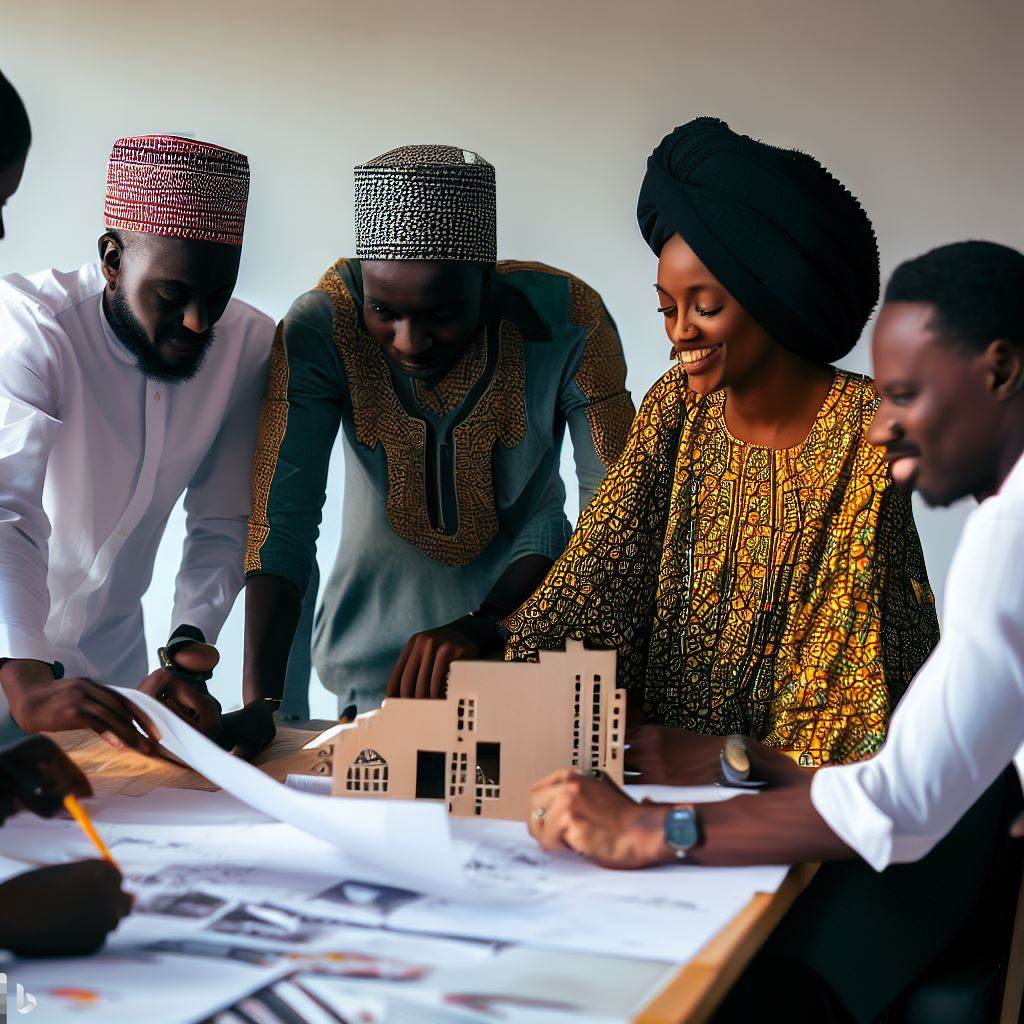Introduction
Explanation of the Nigerian Culture
Nigeria is a country with over 250 ethnic groups, each with unique cultural practices and beliefs. These diverse cultures shape the way Nigerians interact, communicate, and live their everyday lives.
Explanation of Architecture in Nigeria
Architecture in Nigeria is influenced by several factors such as climate, available building materials, and cultural beliefs. Traditional Nigerian architecture is known for its use of local materials and its close connection to nature.
The Connection between Culture and Architecture
Nigerian architecture reflects the country’s diverse cultural heritage by incorporating elements of traditional designs into modern buildings.
Architects often take into consideration cultural beliefs and practices when designing structures, making sure to maintain the integrity of the culture while also adapting to modern design trends.
In essence, the intersection of Nigerian culture and architecture is evident in the country’s buildings, from traditional mud huts to modern skyscrapers.
Understanding the cultural influences behind these structures is important in appreciating the significance of Nigerian architecture.
Read: How Nigerian Architecture Responds to Climate Change
Nigerian Traditional Architecture
Nigeria is known for its rich cultural heritage and this is reflected in its architectural styles.
Traditional Nigerian architecture is characterized by its unique blend of form and function. Here are some characteristics of Nigerian traditional architecture.
Characteristics
- Use of natural materials: The use of local and renewable resources like clay, wood, and stones for building construction.
- Efficient ventilation and lighting: The designs leveraged the natural surrounding elements for ventilation and lighting through openings or voids.
- Inspired by nature: Nigerian traditional architecture embraced organic shapes and solutions that were harmonious with the local climate and environment.
- Decorative motifs: The use of decorative motifs in the buildings is a reflection of the various cultural identities of the people.
Importance of Traditional Architecture
Nigerian traditional architecture is more than just aesthetically pleasing. It holds a significant cultural and historical value to the people. Below are some reasons why traditional architecture is important in Nigeria.
- Heritage Preservation: Traditional architecture is a way of preserving the identity and heritage of the people.
- Sustainability: The use of natural materials makes traditional architecture an eco-friendly approach to building.
- Reflects Local Needs and Tradition: Nigerian traditional architecture is designed to cater to the needs and aspirations of the local community. It reflects tradition, culture and values.
Examples of Traditional Buildings
You can find traditional Nigerian buildings in different parts of the country, and these buildings vary in terms of style, function, and form.
Here are some examples of Nigerian traditional buildings that hold significant cultural and historical value.
- The Oba’s Palace in Benin City, Edo State: A structure that dates back to the 13th century, and it is known for its intricate carvings and architectural detailing.
- The Mbari House in Owerri, Imo State: A sacred structure used by the Igbo tribe for their religious ceremonies. It is characterized by its unique mud architecture and decorative motifs.
- The Panshekara Earth mosque in Kano State: A grand Mosque made of earth and clay, it features a design that allows for natural ventilation and lighting.
- The Agbogun Gboro village in Oyo State: A complex of mud-walled structures with conical roofs in tune with nature and reflects the artistry of the present Yoruba people.
In essence, Nigerian traditional architecture has stood the test of time and continues to inspire modern architecture designs in Nigeria.
It is a reflection of the people’s cultural identity, traditions, and values. Preserving Nigeria’s cultural heritage entails conserving traditional architecture, using local materials, organic forms, and rich symbolism.
Read: A Tour of Nigeria’s Most Iconic Architectural Structures
Western Influence on Nigerian Architecture
The influence of Western architecture on Nigerian architecture cannot be denied. This influence began with colonialism and has continued to shape Nigerian architecture to this day.
Despite the criticisms of this influence, there are also examples of the successful incorporation of Western styles into Nigerian architecture.
Colonialism’s Effect on Nigerian Architecture
British rule during the colonial era heavily influenced Nigeria’s architecture, seen in material usage like brick and stone, and in government buildings, churches, and public structures’ design.
The British also introduced new construction techniques and building codes, which became the norm for Nigerian architecture.
However, colonialism did not only bring positive influence to Nigerian architecture. During this period, the British attempted to impose their styles and techniques, leading to the loss of many traditional Nigerian architectural practices.
Additionally, the British did not consider the environmental and cultural context of Nigeria and often created buildings that were not suitable for the climate or local customs.
Examples of Western Architectural Styles in Nigeria
Despite the negative effects of colonialism on Nigerian architecture, there are also examples of successful incorporation of Western styles into Nigerian architecture.
Bulgarian architect Vojin Bakić designed the National Theatre in Lagos, inspired by the ancient city of Ife, showcasing Brutalist architecture. It is widely recognized as one of Nigeria’s most iconic buildings.
Another example of Western influence on Nigerian architecture is the Eyo Ita House in Calabar.
The building is a blend of Victorian and Nigerian architectural styles, with its bright colors and ornate decorations.
The building was once the home of Eyo Ita, a prominent Nigerian politician and lawyer, and is now a heritage site.
Criticisms of Western Influence on Nigerian Architecture
Despite the successful examples of Western influence on Nigerian architecture, there are also criticisms of this influence.
Some argue that the imposition of Western styles and techniques has led to the loss of traditional Nigerian architectural practices.
Critics argue that Western architecture disregards Nigeria’s cultural and environmental context, resulting in unsuitable buildings.
Furthermore, some argue that the legacy of colonialism has created a sense of inferiority among Nigerian architects, leading to a reliance on Western styles.
This has made it difficult for Nigerian architects to create a truly unique Nigerian architecture that reflects the country’s culture and traditions.
The influence of Western architecture on Nigerian architecture is undeniable.
While colonialism brought both positive and negative influences, there are also successful examples of the incorporation of Western styles into Nigerian architecture.
We cannot ignore criticisms of this influence, as they pose vital questions about preserving Nigerian cultural and architectural practices.
It is important for Nigerian architects to continue to explore and incorporate traditional Nigerian architecture into their designs, while also drawing inspiration from Western styles in a way that is respectful and context sensitive.
Read: Dissecting The Architect Registration Council of Nigeria

Contemporary Nigerian Architecture
In recent years, Nigerian architecture has undergone a significant transformation towards modernity while still maintaining traditional elements, creating a unique blend of contemporary and cultural design.
Characteristics
- Contemporary Nigerian architecture combines modern and local materials.
- It incorporates traditional design elements such as courtyards, terraces, and verandas.
- Buildings are designed to reflect Nigerian culture and aesthetics while also being functional and sustainable.
- They feature a variety of shapes, sizes, and textures, and are often brightly colored.
- Contemporary Nigerian architecture is innovative, experimental, and has an emphasis on energy efficiency.
Examples of Contemporary Architecture in Nigeria
One of the most prominent examples of contemporary Nigerian architecture is the African Heritage House in Lagos.
Designed by architect Theo Lawson, the building features a series of interconnected cubes with a red and white color scheme inspired by traditional Yoruba textiles.
The structure includes an open-air courtyard and rooftop terrace that offers views of the city skyline.
The National Arts Theatre in Lagos is another notable example of contemporary Nigerian architecture.
Bulgarian architect Marko Fabris built the circular building in 1976, drawing inspiration from the traditional Nigerian Yoruba drum.
The design incorporates local materials like red clay tiles and decorative screens.
Changes in Nigerian Architecture in the last decade
In recent years, there has been a significant shift towards sustainable and eco-friendly design in Nigerian architecture.
Nigeria’s architects increasingly focus on environmental issues and efficient building practices. They often use locally-sourced materials in their projects.
Energy-efficient technologies, such as solar panels and wind turbines, feature prominently in their designs. Green spaces and natural ventilation systems are being incorporated to boost indoor air quality and lower energy use.
The government invests in sustainable infrastructure like the Abuja Light Rail project. This project aims to ease congestion and foster sustainable transport.
Nigerian culture and architecture merge to create an innovative, dynamic design approach. This approach echoes the nation’s rich, diverse cultural heritage.
Modern Nigerian architecture melds traditional elements with modern techniques and materials. The result: unique, functional, aesthetically pleasing, and sustainable buildings.
Read: Innovation in Nigeria: Highlighting Futuristic Architecture
Cultural and Traditional Influences in Contemporary Nigerian Architecture
Every building in Nigeria is informed by cultural and traditional elements, blending indigenous ingredients with global influences.
Factors influencing the blending of Culture and Architecture
The influence of culture and tradition on contemporary Nigerian architecture cannot be overemphasized.
It is an important factor in the design and construction of buildings. Here are some factors that influence the blending of culture and architecture:
- The rich cultural diversity of Nigeria with over 250 ethnic groups and various traditions shapes the architectural landscape.
- Hot and dry weather in the northern regions influence building design, leading to the use of materials like mud and clay for temperature regulation.
- The introduction of modern materials and techniques, such as reinforced concrete and steel, has made it easier to blend tradition with contemporary architecture.
- The need for sustainable designs that cater to the environment in which they are built is also a major influence.
Examples of Buildings that reflect the blend of Culture and Architectural Inspiration
Several notable buildings in Nigeria reflect the blending of culture and architectural inspiration. Below are examples of such buildings:
- In Lagos, the National Theatre is a contemporary design inspired by traditional Nigerian motifs. It features a central space covered by a dome supported by a network of concrete arches, nodding to traditional African architecture.
- The Ahmadu Bello University in Zaria is another example of how culture influences architecture. The university was designed as a series of courtyards and organic structures that mimic the traditional architecture of the Hausa people.
- The Lekki Conservation Center in Lagos is a modern architectural structure located on a 78-hectare wetland area. The building blends seamlessly with the landscape and incorporates elements of traditional design, including a set of wooden boardwalks that connect different areas of the center.
- In Abuja, the New Work Station Building is a unique design reflecting Nigeria’s traditional earthen architecture. It features a natural ventilation system and highlights the cultural heritage of the Yoruba ethnic group.
Criticisms of the Current Approach
While there has been a commendable effort to blend culture and architecture in contemporary Nigerian buildings, there are criticisms of the current approach.
Critics say that architects have focused too much on reproducing traditional designs rather than adapting them to modern needs.
Also, there is an apparent lack of creativity to produce innovative cultural designs that cater to the specific needs of the different ethnic groups in Nigeria.
Therefore, the intersection of Nigerian culture and architecture will continue to evolve, blending traditional and contemporary architectural designs.
Architects have a responsibility to adapt to the cultural environment in which they operate while finding creative solutions to modern challenges.
Read: Breaking into the Architecture Scene of Nigeria: A Guide
Conclusion
A recap of how Nigerian culture and architecture intersect reveals the inherent fusion of modernity and tradition.
From the use of natural materials to the incorporation of symbolism and spirituality, Nigerian architecture embodies the spirit of the people.
Final thoughts suggest that this intersection is key to the promotion of Nigerian identity and national pride. Through expression in architecture, Nigerians are able to celebrate their rich heritage and diversity.
Future development should prioritize conserving historic structures and creating innovative designs inspired by Nigeria’s cultural motifs.
By doing so, Nigeria can continue to showcase its cultural brilliance through the art of architecture.




